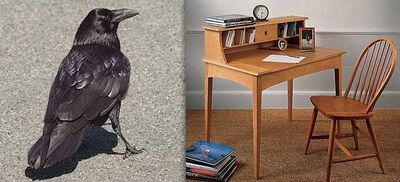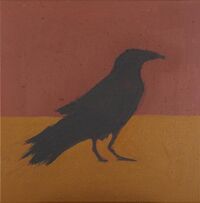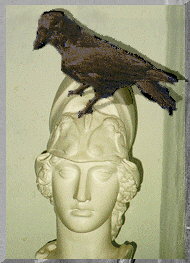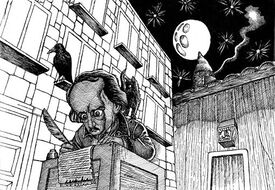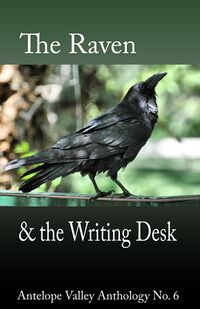Why?:Is a Raven Like a Writing Desk? An Historical Perspective
“QVARE RAVENABVS EST SIMILVS SCRITORIVM?”
“Perché é il corvo come la scrivania?”
Why is a Raven Like a Writing Desk? is a riddle older than time itself, seen in many incarnations throughout the ages. From prehistoric times to the era of the Talmud to the 19th Century sweatshops of Lewis Carroll's London, the riddle has staggered the best and brightest minds of history.
Archeological relics, historical texts, and anecdotal evidence all suggest that people have been asking themselves, "why is a raven like a writing desk?" since the dawn of humanity. Although not meant to be a comprehensive discussion, the following survey will explore the topic from a historical perspective to help ground the reader in the foundations of the age old question, to wit, why is a raven like a writing desk? ("WIARLAWD").
Prehistoric Origins
The evidence of prehistoric WIARLAWD is scant, but it does exist. In cave paintings found in modern-day France, archeologists have found drawings of what appears to be a black bird perched on desk-shaped rock. The drawings have been carbon-dated to between 30,000 and 25,000 years B.C. In her dissertation on ancient hominids and their relationships with aviary creatures, Professor Alice Carol of Oxford University proposed that the early humans who lived in the caves were obsessed with ravens and early drawing utensils. Although no concrete cause for the obsession has been demonstrated, Dr. Carol to this day travels the lecture circuit advocating her "Caveman WIARLAWD" theory.
Biblical Times
In the Book of Xerxes (non-canonical), the Bible makes a mysterious albeit indirect allusion to WIARLAWD: "And ye shall travel the world with not a possession, not even an ass; yet ye shall but quothe the raven at its writing desk." (Xerxes 16:4) As part of the non-canonical Old Testament, the Book of Xerxes has been dissected by Jewish, Christian, and Muslim scholars alike. All agree that WIARLAWD is referenced in Xerxes, but there the agreement ends. Famous Christian theorist and historian C.S. Lewis believed that WIARLAWD was not a riddle at all, but an admonition. In the Koran, Mohamed himself is said to have been inspired to dictate that WIARLAWD was a reference to the Genii, mystical spirits with supernatural powers. And historians of the Torah and the Talmud have long argued that WIARLAWD is a direct reference to the Judaic proscription against pride. Still, there is no consensus amongst historians of the Biblical era that WIARLAWD had coalesced into a true riddle. It would seem that remained for later times.
Classical Times
By the time of the ancient Greeks and Romans, there is no doubt that WIARLAWD had become a question that longed to be answered. Greek philosophers Plato and Aristotle both wrote of WIARLAWD and argued over whether the raven should be considered one of the fundamental elements, along with earth, wind, fire, and water. Pliny the Elder wrote in his treatise on writing utensils, "Quare Ravenabus est similus scritorium?" Even the famous orator and statesman of ancient Rome, Cicero, repeated the question. He then argued the point to the Senate during the famous trial of Bluto in 44 B.C, eloquently stating, "If not like a writing desk, what is a raven? But a winged creature that circles in heaven? Surely not. No, my fellow Romans, the raven is not just like the writing desk; the raven is the writing desk!" The acquittal of Bluto in 43 B.C. proved that the Senate was swayed, but later scholars would prove harder to convince.
Medieval Era
The greatest medieval minds grappled with WIARLAWD but were unable to advance the concept beyond where it lay in Late Antiquity. Saint Thomas Aquinas argued in his Theorem Ravenabus (1234 A.D.) that the Raven was not like a writing desk at all, but more like a footstool. Still other scholars "rediscovered" the classical works of Pliny and Cicero through Arab and Greek translations in the late 14th Century, thus advocating that the writing desk and the raven were one and the same - all part of God's plan. As the Middle Ages came to a close, however, it was apparent that the philosophers and sages of the day had no unified answer to WIARLAWD.
The Renaissance and the Age of Reason
Michelangelo; Leonardo da Vinci; Dante Alighieri; names that echo in history as beacons of light emerging from a dark tunnel of cloistered human thought. None of these masters, however, were able to solve the puzzle of WIARLAWD. Art historians have argued that the answer to WIARLAWD is encoded in Michelangelo's painting of the Sistine Chapel, yet none have been able to step forward with a coherent explanation of how that solution manifests itself. Leonardo da Vinci attempted to sidestep a verbal solution to the question of WIARLAWD by drawing blueprints for a flying machine that was part-raven, part-writing desk. Modern computers have been unable to use the plans to build a working prototype, however. Even the great Dante Alighieri tried to explain WIARLAWD, without success: "And at the fifth circle of Hell, I found souls running in a circle, writing desks strapped to their heads, and ravens pecking out their eyes, while demons and evil spirits hurled racial epithets at them."
By the Age of Reason in the 1600's and 1700's, enlightened minds took an entirely opposite tack. Voltaire quipped, "We must cultivate our gardens, but must let WIARLAWD alone once and for all." Thomas Jefferson, while fighting the War of Colonial Aggression, wrote in his private diaries that WIARLAWD was pure nonsense; "if anything, a raven is but like a feathery byrd, and not a writing deske in the least." Benjamin Franklin was quoted once as saying that three could keep a secret, as long as two were dead and the secret was not the answer to WIARLARD. In an age of Deists, who believed in God as a clockmaker who had left the scene of the World to run on its own, the great thinkers of the Enlightenment were glad enough to leave WIARLAWD alone.
During the Industrial Revolution - The Raven and Alice in Wonderland
Ravens took on a special significance in literature in the 1800's as the Industrial Revolution came into full swing. First, the American author and poet Edgar Allan Poe wrote a scathing critique on ravens in his poem, "The Raven." Poe addressed the mystery of the Raven since the dawn of history in his poem by situating it on a bust of Pallis, a figure from classical antiquity. He equated the raven with the dark foreboding of midnight ponderings, weak and weary. Furthermore, Poe made the raven an emblem of ridiculous fear and loss, having the raven answer a series of questions with a single word. The climax of the poem comes when Poe's character ponders, "Why is a raven like a writing desk?", only to hear the Raven respond, "Nevermore!"
Later in the same century, English author Lewis Carroll wrote his masterpiece of logic, Alice in Wonderland. Much as the great Romans and Greeks before him, Carroll attacked the question of WIARLAWD. During a tea party with a rabbit and a crazy haberdasher, Carroll's protagonist and heroine, Alice, is asked the eternal question. Although Alice provides no satisfactory answer to the riddle in Carroll's work, the very fact that the question had been raised was of great importance. First, it was the first time in history that a non-religious, fictional work depicted the great question of WIARLAWD. Second, it was the first time that a Mad Hatter had ever asked a question about a raven and a writing desk to a little girl. Finally, third - and most important of all - Carroll's reference marked the first time in recorded history that an author asked the question of WIARLAWD directly in the English language.
Modern Incarnations
WIARLAWD is a question that remains with us even in today's digital age. As any internet search reveals, the question of WIARLAWD remains as compelling today as it was 40,000 years ago. Some experts even predict that computerized artificial intelligence will soon enable us, at last, to use computers to generate multiple logical solutions to the same riddle.
Analysis
So, what does all of this mean?
Hell if I know. Uncyclopedia has an article about the answer, but I haven't read it; see Why?:Is a raven like a writing desk?
See Also
- Why?:Is a raven like a writing desk?
- Alice in Wonderland
- Lewis Carroll
- Edgar Allan Poe
- Aristotle
- Plato
- Voltaire
- Voltran
- Cicero
- Bible
- Jesus Christ
- Carpenter
- Raven (bird)
- Raven
- Cavemen
- Cave women
- Riddle
| Featured version: 3 September 2013 | |
| This article has been featured on the main page. — You can vote for or nominate your favourite articles at Uncyclopedia:VFH. | |
